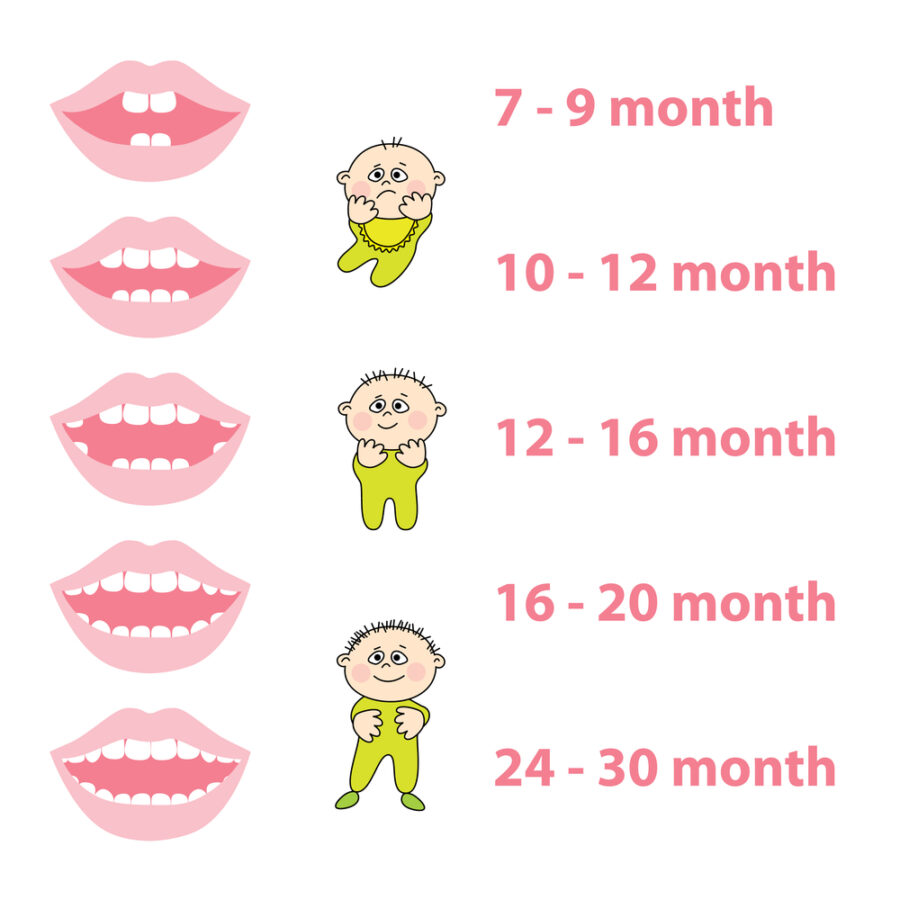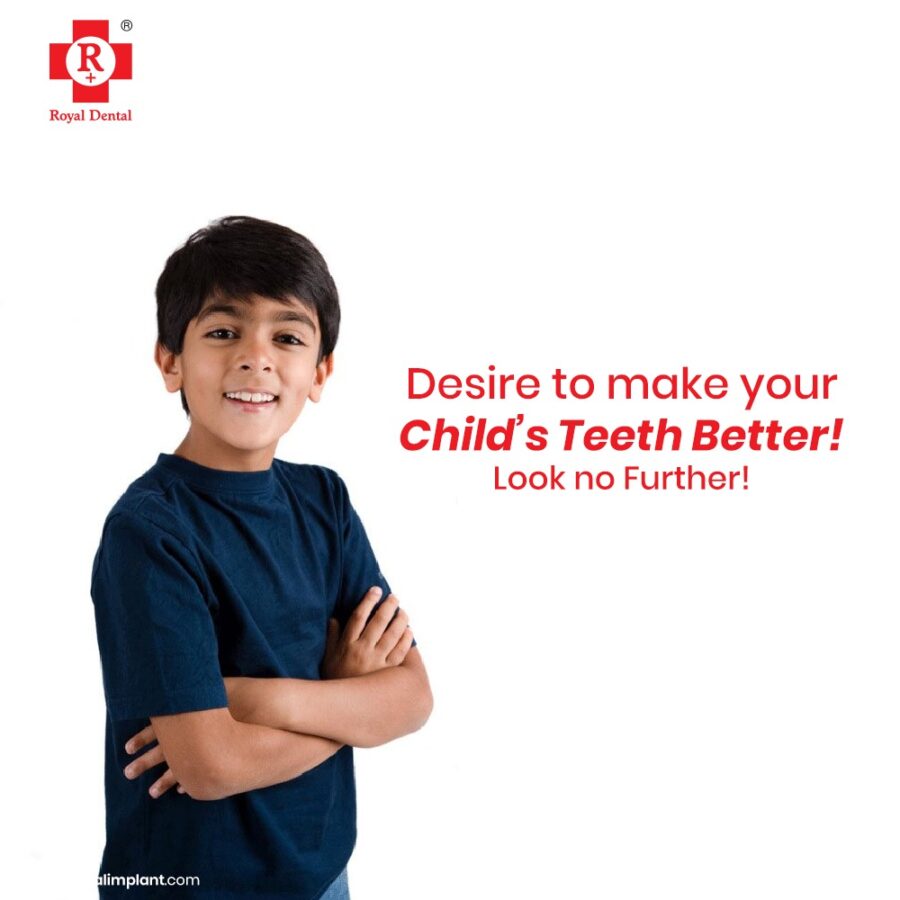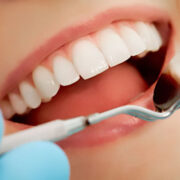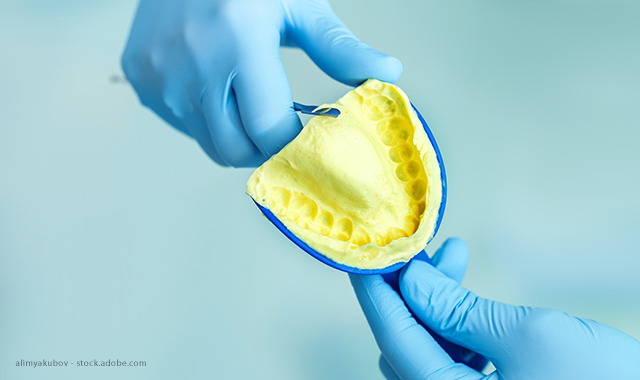When your child is teething, it can feel like the world is ending. It can also feel like your child has suddenly developed an affinity for chewing on everything in sight. Chewing also becomes more of a challenge for your little one because their gums are likely to be extremely tender and sore. Wrinkly red gums and an inability to soothe that soreness with your fingers or a pacifier are signs that your baby is teething – probably starting around his first birthday. Erupting teeth in babies can be painful or irritating. If you have a teething baby at home, you’ve come to the right place! In this article, we’ll cover everything you need to know about baby teething!
Teething starts at around 6 months when baby teeth will begin erupting and continue to 3 years of age. Usually, the first teeth to erupt are the bottom front teeth (incisors). Between the age of 6 and 12 children have a combination of baby and adult teeth, as their baby teeth are gradually replaced by 32 adult teeth.
When does a Baby start Teething?
The first tooth to appear is usually one of the bottom incisors – the ones right next to the gums. These commonly start to break through around the time that your child is 12 months old. Teething can begin as early as 7-9 months, but it’s not uncommon for it to start as late as 12-16 months. One sign that your child’s first teeth are on their way is that their gums will be swollen, red and puffy.

They will probably drool more than usual and may be fussy and cranky. Your baby may also experience some mild abdominal pain, which can be more noticeable when lying down. Teething can cause a loss of appetite and some slight diarrhoea, so keep an eye on your baby’s diaper output.
Signs that your Baby is Teething
The best way to know for sure if your baby is teething is to look for the signs. They include red and swollen gums, increased drooling, irritability, and an affinity for chewing on anything and everything. If your baby has a fever, diarrhoea, or is uncharacteristically fussy, teething is most likely not the cause. Because your child’s teeth are forming well before they break through the gums, you can’t actually see them growing. But you can see the signs of impending teething pain: swollen gums, a tender mouth, and teeth marks on everything in sight
What to expect when Baby Teeth are erupting?
The process of teething begins when the first tooth begins to emerge from the gums. At this time, a baby’s mouth is full of soft, spongy dentin, a substance that is rich in minerals and vitamins. The baby’s body will begin metabolizing the minerals within the dentin, which will cause the gums to soften and swell. Teething can be an uncomfortable process for your baby, but there’s usually nothing to worry about.
It’s normal for your baby to drool and chew on everything in sight as he works to ease the pain and pressure as baby teeth break through the gums. Teething can cause your baby’s temperament to change, making him fussy and irritable. He may also be more prone to infections since he’s drooling more than usual and doesn’t have the best hand-washing technique down yet.
How to soothe a Teething Baby?
The first step to soothing a teething baby is to make sure they’re hydrated. A teething baby is more prone to dehydration, so make sure he is drinking enough breast milk or formula. Teething gels are an easy way to soothe a teething baby. You can apply them to your baby’s gums to help relieve pain and reduce swelling. You can also try teething rings, chew toys, cold washcloths, or frozen fruit and vegetables that are designed for teething babies.

If your baby is dealing with a lot of drool, you may want to use a bib to protect his clothes from getting soaked. Teething babies usually produce more saliva than normal – especially when teething is at its worst. This means that drool is likely to be soaking his chin and clothing almost constantly. Teething babies tend to be attracted to textures that are different from what they’re used to feeling in their mouths. This is also why teething babies often try to gnaw on their own hands or fingers, sometimes even to the point of drawing blood.
If your baby is chewing
If your baby is 6 months or older, you can give them healthy things to chew on, such as raw fruit and vegetables. Soft fruit like melon can soothe gums. You could also try giving your baby a crust of bread or a breadstick. Always watch when your baby is eating in case they choke.
Tips for helping your Teething Baby
If your baby is teething, you can help her through the process by keeping her hydrated, giving her plenty of chew toys or frozen food to gnaw on, and helping her to keep her hands away from her mouth. You can also try teething gels to ease pain and swelling, or find other baby teething remedies. Just remember that babies don’t have any control over their hands, so they are likely to use them in ways that are not helpful.
Be sure to keep your little one’s hands away from his mouth as much as possible. If your baby has an infection like a cold or bacterial infection, the teething process might not be the only cause of the symptoms. If your baby has a fever, diarrhoea, or is uncharacteristically fussy, teething is most likely not the cause.
Bottom line
Teething can be a challenging experience for parents and babies alike. Traditional teething remedies like cool cloths, gum massages, and teething rings are excellent ways to soothe your baby’s gums and ease discomfort. As with all aspects of parenting, try not to get too stressed out and remember that each phase even the difficult ones will pass in due time.






